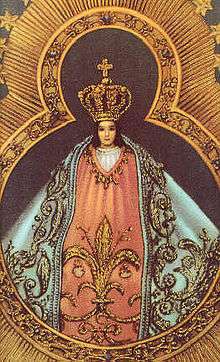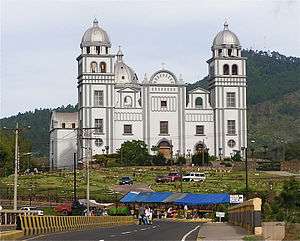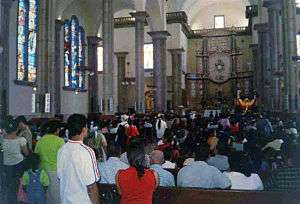Virgin of Suyapa
Coordinates: 14°4′49.66″N 87°9′27.51″W / 14.0804611°N 87.1576417°W
| Virgin of Suyapa | |
|---|---|
 | |
| Our Lady of Suyapa, Patroness of Honduras | |
| Venerated in | Roman Catholic Church |
| Major shrine | Basilica of the Virgin of Suyapa, Honduras |
| Feast | February 3 |
| Patronage | Honduras, Central America, Orden de los Caballeros de Suyapa |
The Virgin of Suyapa (Spanish: Virgen de Suyapa) is an 18th-century statue (6 cm/2.3 in) of the Virgin Mary, mother of Jesus Christ. The statue, also known as Our Lady of Suyapa (Spanish: Nuestra Señora de Suyapa), is perhaps Honduras' most popular religious image, and the focus of an extensive pilgrimage.[1][2]
The statue is kept in the Basílica de Suyapa in Suyapa, a suburb of the capital Tegucigalpa, and toured through various other parts of Honduras each year in early February. Many thousands of people from all over Central America make pilgrimages to visit the statue on her name day, February 3rd, a commemoration of the day she was found. The statue has been stolen and then recovered on two occasions.[3][4]
Our Lady of Suyapa is the Patroness of Honduras.
Discovery


There are several different versions of how the statue that is the Virgin of Suyapa was discovered. The version that has become standard is recounted below.
Many Hondurans believe the statue was miraculously discovered in late January or early February 1747 by a labourer, Alejandro Colindres. Colindres and an 8-year-old boy had been sent by Colindres's mother to clear some cornfields on Piligüin mountain, northeast of Tegucigalpa. On the way back, they were overtaken by nightfall and decided to sleep outside. During the night, Colindres was awakened by a sharp pain in his side, and discovered that he was sleeping on something.
Later versions of the story claim that without looking at the object, Colindres threw it as far away as he could, only to find it underneath him as he lay down again. This detail, however, is not present in early versions of the story. The next morning, Colindres discovered that he had been sleeping on a tiny statue of the Blessed Virgin Mary, which he took home with him and set up on the family altar in his mother's house.
There it remained for the next 20 years. It was not until 1768 that the statue was credited with its first recognized miracle and began to attract public attention. By 1777, a chapel was constructed for the statue.
Veneration
The statue of the Virgin remained in Colindres's mother's house for 20 years, until the first miracle was recorded in 1768. At that time the family began collecting funds to build a chapel, which was completed in 1777. Pope Pius XI declared her Patroness of Honduras under the title Our Lady of Suyapa, and selected February 3 as her feast day in 1925.
In 1954, a large Basilica was built next to the chapel. The statue of the Virgin spends most of her time in the chapel, but every year before the celebration of her festival, the statue is moved into the larger church to accommodate the crowds.
The statue of the Virgin of Suyapa has a group of lay caretakers, all male, known as the Orden de los Caballeros de Suyapa, founded in the 20th century. They are responsible for caring for the image, and the small chapel. They escort the statue whenever it leaves the chapel to travel around Honduras, as it often does every February.
The statue is considered to have miraculous powers. The swift ending of the Football War between Honduras and El Salvador is attributed to the statue. Many of the Honduran soldiers involved reported visions of the Virgin, which calmed their fears during the fighting.
See also
References
- ↑ Article on the virgin
- ↑ Amid a Crisis, Hondurans Heap Large Hopes on a Tiny Religious Icon The New York Times (www.nytimes.com). Retrieved 2012-08-13.
- ↑ Article on the virgin
- ↑ Amid a Crisis, Hondurans Heap Large Hopes on a Tiny Religious Icon The New York Times (www.nytimes.com). Retrieved 2012-08-13.
- Barceló Morey, Jose. 2000. La Inmaculada Concepción de María en Honduras: La Inmaculada Concepción de Suyapa, Patrona de Honduras. San Pedro Sula: Editorial/Librería Coello
- Valladares B., Juan R. 1946. La Virgen de Suyapa (historia documentada). Tegucigalpa: Tallereres Tipo-Lito.
External links
- Official Catholic church site Spanish
- Virgin of Suyapa visits Honduran suburb devastated by massacre
- Article in Spanish on sources of the story